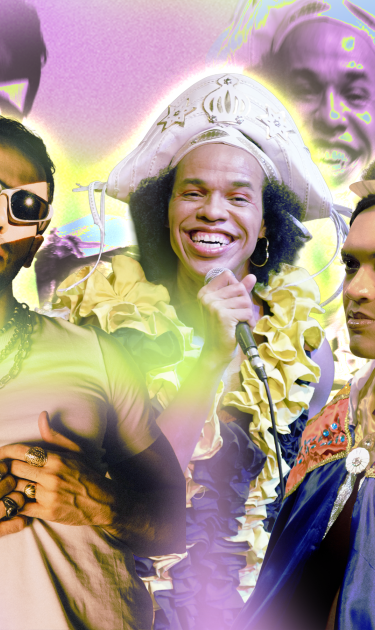In Recife, the capital of Brazil’s northeastern state of Pernambuco, frevo isn’t just music or a Carnival tradition — it’s a political statement. For most of its 118 year history, frevo’s stages have been dominated by cis, heteronormative performers. These days, queer people are leading the change. LGBTQ+ artists are taking up space in the streets, on the mic, and in the culture. Frevo, after all, has always been about rebellion.
Fast, feverish, and impossible to ignore, frevo is a full-body experience. Musically, it’s a high-octane fusion of brass band traditions — think trumpets, trombones, tubas, and snare drums — blasting in frenetic syncopation. The tempo is breakneck, with rhythms rooted in military marches, polka, and Brazilian maxixe, but turned up to carnival-level intensity. On the streets, dancers known as passistas leap, kick, squat, spin, and improvise choreography that looks part-capoeira, part-gymnastics, and all heart. They often twirl tiny colorful umbrellas not for shade, but as an extension of the body, a prop for flair and footwork. There’s no stillness in frevo: it demands movement, freedom, and joy. It’s music that doesn’t just ask you to dance — frevo dares you.
Before performing her set at Casa de Francisca in São Paulo — a venue known for spotlighting diverse voices in Brazilian music — trans artist Caetana gets ready in a flowing green dress, smiling as she recalls her roots. Born in Coque, a community in Recife, she grew up listening to her maternal grandmother, nicknamed passarinha (little bird), humming around the house. From her paternal grandmother, she learned about the Orixás — ancestral deities from Afro-Brazilian religions like Candomblé and Umbanda, who guide and protect individuals. “I think I’m a great mix of the two,” she says. “From one, I learned to sing; from the other, I inherited the spiritual principles that shape me. Out of that mixture came me.”
That mix runs through her 2023 album Afronordestina, a project she describes as a celebration of Northeastern culture. Produced by Passarinho and Erami Neto, the album features collabs with Deize Trigona, Nilla, La Rubia, and Formiga Dub — all artists pushing boundaries in Brazil’s music scene. “I believe frevo has always belonged to the queer community,” Caetana says. “But because of how often our bodies and voices are erased, we were always pushed to the back.”

She’s not wrong. Despite being the only trans artist actively working with frevo in Recife, she wasn’t invited to perform at the city’s first-ever Frevo Festival. “I questioned it, and they said they only receive proposals, but they don’t choose the lineup,” she says. “But if you’re supporting a project, why not make space for dissident bodies?”
Luckily, she’s not the only artist kicking doors open, like Romero Ferro, who blends frevo, brega, synth-pop, and glitter equally in his music. Born in Garanhuns (also in Pernambuco), he grew up loving frevo but didn’t always see space for himself in it. That changed after he created Frevália, a music project born in 2016 to bring frevo out of the Carnival season and into year-round rotation. What started as a concert series became both an album and a movement, creating space for LGBTQ+ artists to take center stage and proving that frevo doesn’t have to be stuck in the past or limited to just one time of year. Frevália reimagines the genre through a queer, pop-infused lens, mixing traditional brass with bold visuals, fashion, and inclusivity.
In 2023, the show Frevália took over Galo da Madrugada: Recife’s massive Carnival parade and the biggest in the world alongside Pabllo Vittar, Gaby Amarantos, and Juliette. In 2024, he dropped a full Frevália album, which included features by legends like Daniela Mercury and Lia de Itamaracá. “Frevo is often tied to a heteronormative tradition,” he explains. “But we live in a sexist, racist, LGBTphobic society that blocks us from the stage. Frevália is about resisting that and being visible.”

Of course, visibility has its costs. “Whenever we show up, the backlash comes,” Romero says. “People say frevo is ‘losing its roots,’ but the truth is frevo has always evolved”. In Brazil, where violence against LGBTQI+ people remains high, joy itself can be revolutionary. In 2024, deaths of LGBTQ+ people rose by over 13 percent, according to the Grupo Gay da Bahia. For queer artists, stepping on stage is about survival.
“Frevo has always belonged to the queer community. But because of how often our bodies and voices are erased, we were always pushed to the back.”
That’s something Elon, a non-binary artist from Paraíba, knows firsthand. After a Carnival trip to Olinda, they ended up writing two frevos: “Quem tá no frevo é pra se molhar” (“If you’re in the frevo, you’re meant to get soaked”) and “Folia Maracajá.” “I didn’t plan to be a frevo artist, it just happened in the heat of the street,” Elon says. Making music since they were four, Elon is currently working on their first solo album, TRANSVERBERAR, due later this year. It blends Northeastern rhythms with pop sensibility and touches on everything from tech to emotion to identity. “I don’t make ‘queer music,’ I make Brazilian music. But my body is queer, so of course it’s in there.”
For both Elon and Caetana, frevo isn’t just a rhythm — it’s a language of survival and memory. “Frevo is resistance,” Caetana says. “It’s Afro-Indigenous knowledge, it’s connection, it’s self-worth. That’s why we dance in the streets. Because the street is ours.”

She wants people to look at the streets differently, not just as places to pass through, but as spaces of joy and freedom. “The street is where we exist, where we breathe, where we meet. That’s where our identity is built.”
And at the heart of it all? Frevo. “Frevo embraces everything,” she adds. “It’s spontaneous, it’s free, it’s alive. Frevo is the street.”




